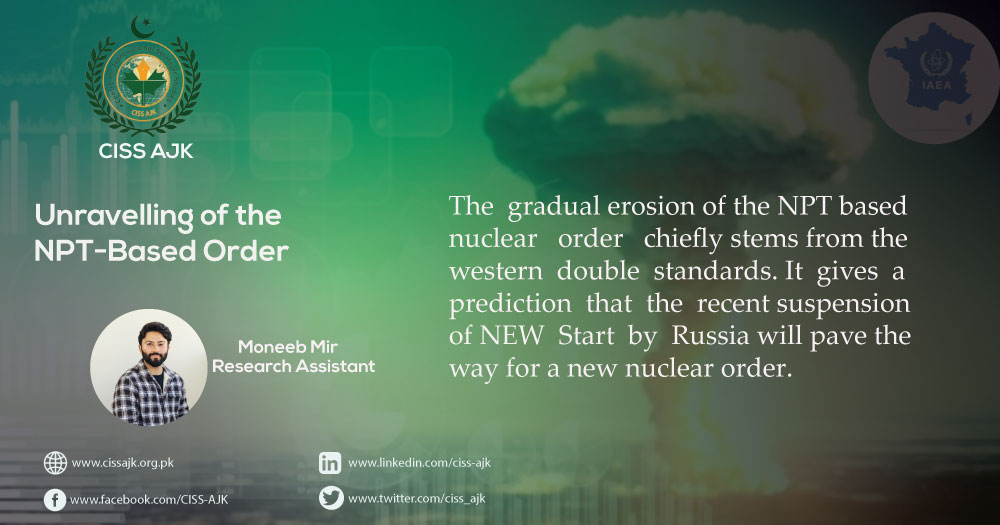851
Ever since the advent of nuclear weapons, in the past half-century, there had been a gradual formation of an international nuclear order primarily based on NPT. The nuclear order revolved around three key norms of nuclear restraint: deterrence, non-use, and non-proliferation. Lawrence Freedman, a British Foreign Policy expert, also terms this order the “twin pillars” of the global nuclear order: mutual stability in the major nuclear rivalry and non-proliferation to inhibit or prevent the spread of nuclear weapons to additional states. The order, however, appears to be withering due to a myriad of challenges. As the unresolved asymmetry in the ‘bargain’ between nuclear and non-nuclear states has created a growing sense of scepticism among the latter towards the existing nuclear order. The politics of such an inequality became more conspicuous during the NPT review conferences. Ninna Tannenwald opines that “what was supposed to be a transformation (NPT) regime—the transformation to a disarmed world—has become a status quo regime.”
William Potter, Director at James Martin Centre for Non-proliferation Studies, has pointed out, “the NPT is not as explicit as one might like in prohibiting the use of nuclear weapons, or even the threat of their use against nonnuclear states.” Such inherent flaws have led to the emergence of the Treaty on the Prohibition of Nuclear Weapons (TPNW), which calls for a complete ban on nuclear weapons. The treaty represents a significant departure from the traditional disarmament approach, which has often focused on the reduction and regulation of nuclear arsenals rather than their outright elimination. The treaty may be the first legally binding international agreement to comprehensively ban nuclear weapons, however, with an overwhelming 92 signatories and 68 parties, it has set a new counter-precedent to the established status quo of NPT.
Similarly, the COVID-19 pandemic has ushered in an era of de-globalisation, which fuelled the already widespread notions of nationalism and populism. Countries have begun to move inwards thereby creating a more myopic security outlook. Aspirations to make nuclear weapons, which once seemed taboo in the previous nuclear order, have commenced surfacing. South Korea, a long-standing American ally, has recently signalled a willingness to explore the possibility of acquiring nuclear weapons. The rising sense of hyper-nationalism, in countries like India, whose leaders have incessantly flaunted nuclear weapons against neighbouring Pakistan has contributed to discrediting deterrence politically. The advent of new technologies is posing significant challenges to the task of securing nuclear thereby undermining one of the foundations of stable nuclear deterrence between rivals. The humanitarian campaign has also been instrumental in curtailing the legitimacy of deterrence, as the threat to ‘kill millions’ is increasingly viewed as morally unacceptable. Some experts like George Quester, a professor at the University of Maryland, have argued that the notion of deterrence constitutes a form of ‘moral hypocrisy’.
Non-nuclear states have been further disenchanted by the preferential treatment accorded to certain states that are seen as ‘friends’ of the west. Glaringly, the US-India nuclear deal of 2008, the Nuclear Supplier Group (NSG) exception for India, the Indo-US growing strategic partnership to counter China, and the US diplomatic protection of Israel’s nuclear arsenal, which exposes double standards of the nuclear order. The discrimination has created a sense of injustice and distrust toward the existing nuclear order. This resulted in nonnuclear states seeking alternative routes to disarmament and further undermining their commitment to non-proliferation. The Russian invasion of Ukraine has also contributed to reinvigorating the nuclear debate. Ukraine, once a nuclear-armed state, relinquished its nuclear weapons under the famous Budapest Memorandum in exchange for security assurances from the world powers. These assurances, however, were not upheld. This has raised two conflicting ideas about the nuclear order. The first is that nuclear weapons can serve as a bulwark against external threats, which can dampen non-proliferation norms. The second is that the lack of security assurances for non-nuclear states, as demonstrated by the situation in Ukraine, can lead to cynicism and distrust toward nuclear states.
The failure of the Joint Comprehensive Plan of Action (JCPOA), also known as the Iran deal, has flared up the already prevalent suspicion among the non nuclear states that the NPT regime perpetuates the status quo. Despite Iran’s compliance with the agreement’s provisions as well as the NPT treaty, the United States withdrew from the deal in 2018 and re-imposed crippling economic sanctions on the country. As the world is fast beginning to look at nuclear power generation as a remedy to the intensifying plight of global warming, as it is a low-carbon source of energy. The biased structure of the NPT regime can make it difficult for non-nuclear states to acquire nuclear technology for civil purposes. This is set to further erase the confidence of the non-nuclear states in the NPT and undermine its effectiveness as a non-proliferation mechanism. Amongst all these developments, the suspension of New START by Russia may up the ante for a new nuclear order that addresses the underlying discrepancies in the existing one. One might even repeat the words of the Italian political theorist Antonio Gramsci “the old world is dying, and the new world struggles to be born.”



